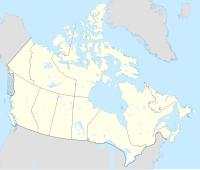Maymont, Saskatchewan
Appearance
Village of Maymont | |
|---|---|
Village | |
 Main Street | |
Location of Maymont in Saskatchewan | |
| Coordinates: 52°33′47″N 107°42′22″W / 52.563°N 107.706°W | |
| Country | Canada |
| Province | Saskatchewan |
| Region | Saskatchewan |
| Census division | 16 |
| Rural Municipality | Mayfield |
| Date Organized | June 24, 1907[1] |
| Incorporated (Village) | N/A |
| Incorporated (Town) | N/A |
| Government | |
| • Mayor | Denise Bernier |
| • Administrator | Laurie DuBois |
| • Governing body | Maymont Village Council |
| Area | |
| • Total | 0.66 km2 (0.25 sq mi) |
| Population (2006) | |
| • Total | 130 |
| • Density | 248.9/km2 (645/sq mi) |
| Time zone | CST |
| Postal code | S0M 1T0 |
| Area code | 306 |
| Highways | Hwy 16, Hwy 376 |
| [2][3][4][5] | |
Maymont is a village in the Canadian province of Saskatchewan. It is ninety kilometres northwest of Saskatoon.
The plaque at the entrance to the town says that the Village of Maymont was named for May Montgomery. She was a niece to William Mackenzie (of Mackenzie and Mann, railway construction contractors, who built the CNR line through the area in 1905). Miss Montgomery had asked her uncle to name the village Montgomery, but he said he couldn't because a town in Manitoba already had that name. So, he took her first name and the first syllable of her last name and combined them to form the name, Maymont.
Demographics
Canada census – Maymont, Saskatchewan community profile
| 2011 | |
|---|---|
| Population | 146 (12.3% from 2006) |
| Land area | 0.66 km2 (0.25 sq mi) |
| Population density | 221.5/km2 (574/sq mi) |
| Median age | 49.5 (M: 49.0, F: 50.0) |
| Private dwellings | 80 (total) |
| Median household income | $NA |
See also
References
- ^ "Archived copy". Archived from the original on February 25, 2012. Retrieved February 17, 2010.
{{cite web}}: Unknown parameter|deadurl=ignored (|url-status=suggested) (help)CS1 maint: archived copy as title (link) - ^ National Archives, Archivia Net, Post Offices and Postmasters, archived from the original on October 6, 2006
{{citation}}: Unknown parameter|deadurl=ignored (|url-status=suggested) (help) - ^ Government of Saskatchewan, MRD Home, Municipal Directory System, archived from the original (– Scholar search) on November 21, 2008
{{citation}}: External link in|format=|deadurl=ignored (|url-status=suggested) (help) - ^ Canadian Textiles Institute. (2005). "CTI Determine your provincial constituency". Archived from the original on 2007-09-11.
{{cite web}}: Unknown parameter|deadurl=ignored (|url-status=suggested) (help) - ^ Commissioner of Canada Elections, Chief Electoral Officer of Canada (2005). "Elections Canada On-line". Archived from the original on April 21, 2007.
{{cite web}}: Unknown parameter|deadurl=ignored (|url-status=suggested) (help) - ^ "2011 Community Profiles". 2011 Canadian census. Statistics Canada. March 21, 2019.
- ^ "2006 Community Profiles". 2006 Canadian census. Statistics Canada. August 20, 2019.
- ^ "2001 Community Profiles". 2001 Canadian census. Statistics Canada. July 18, 2021.


